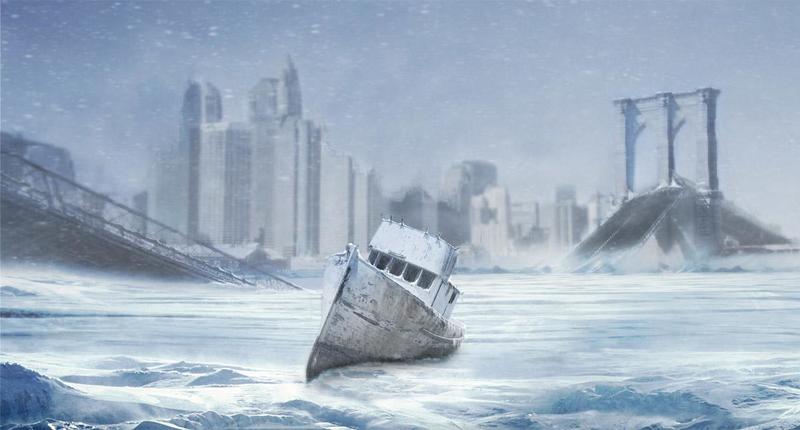“This Is Not A Recession. It’s an Ice Age…”
by Annie Lowery via The Atlantic,
ZeroHedge.com
Sat, 03/21/2020
We can’t say we’re in a recession yet, at least not formally. A committee decides these things—no, really. The government generally adopts the view that a contraction is not a recession unless economic activity has declined over two quarters. But we’re in a recession and everyone knows it. And what we’re experiencing is so much more than that: a black swan, a financial war, a plague.
Maybe things feel normal where you are. Maybe things do not feel normal.
Things are not normal. For weeks or months, we won’t know how much GDP has slowed down and how many people have been forced out of work. Government statistics take a while to generate. They look backwards, the latest numbers still depicting a hot economy near full employment. To quantify the present reality, we have to rely on anecdotes from businesses, surveys of workers, shreds of private data, and a few state numbers. They show an economy not in a downturn or a contraction or a soft patch, not experiencing losses or selling off or correcting. They show evaporation, disappearance on what feels like a religious scale.
What is happening is a shock to the American economy more sudden and severe than anyone alive has ever experienced. The unemployment rate climbed to its apex of 9.9 percent 23 months after the formal start of the Great Recession. Just a few weeks into the domestic coronavirus pandemic, and just days into the imposition of emergency measures to arrest it, nearly 20 percent of workers report that they have lost hours or lost their job. One payroll and scheduling processor suggests that 22 percent of work hours have evaporated for hourly employees, with three in 10 people who would normally show up for work not going as of Tuesday. Absent a strong governmental response, the unemployment rate seems certain to reach heights not seen since the Great Depression or even the miserable late 1800s. A 20 percent rate is not impossible.
State jobless filings are growing geometrically, a signal of how the national numbers will change when we have them. Last Monday, Colorado had 400 people apply for unemployment insurance. This Tuesday: 6,800. California has seen its daily filings jump from 2,000 to 80,000. Oregon went from 800 to 18,000. In Connecticut, nearly 2 percent of the state’s workers declared that they were newly jobless on a single day. Many other states are reporting the same kinds of figures.
These numbers are subject to sharp changes; things like large plant closures lead them to jump and fall and jump and fall. But for them to rise so precipitously, across all of the states? To stay high? That is new. The economy is not tipping into a jobs crisis. It is exploding into one. Given the trajectory of state reports, it is certain that the country will set a record for new jobless claims next week, not only in raw numbers but also in the share of workers laid off. The total is expected to be in the range of 1.5 million to 2.5 million, and to climb from there.
None of that is surprising.
The economy needs to halt to protect lives and sustain the medical system. Planes have been grounded, conferences canceled, millions of Americans told not to leave their homes except to get groceries and other necessities. Because of the emergency measures now in place, businesses have had no choice but to let workers go. The list of employers laying off workers en masse includes cruise lines, airlines, hotels, restaurants, bars, cabinetmakers, linen companies, newspapers, bookstores, caterers, and festivals. I started adding up numbers in news reports, and quit when I hit 100,000.
The economy had been plodding along in its late expansion, growing at a 2 or 3 percent annual pace. Now, private forecasters expect it will contract at something like a 15 percent pace, though nobody really knows. A viral quarantine is impossible to model, because modeling would mean knowing how long the necessary emergency measures will last and how well the government will respond with some degree of accuracy. Still, real-time measures show a consumer-economy apocalypse. One credit-card processor said that payments to businesses were down 30 percent in Seattle, 26 percent in Portland, and 12 percent in San Francisco. Nearly every state is seeing dramatic declines, with hotels and restaurants hit particularly hard.
The markets are not normal, either. The stock market lost 20 percent of its value in just 21 days – the fastest and sharpest bear market on record, faster than 1929, faster than 1987, 10 times faster than 2007.
The financial system has required no less than seven emergency interventions by the Federal Reserve in the past week. The country’s central bank has wrenched interest rates to zero, started buying more than half a trillion dollars of financial assets, and opened up special facilities to inject liquidity into the financial system.

Yet in the real economy, everything has halted, frozen in place. This is not a recession. It is an ice age.

